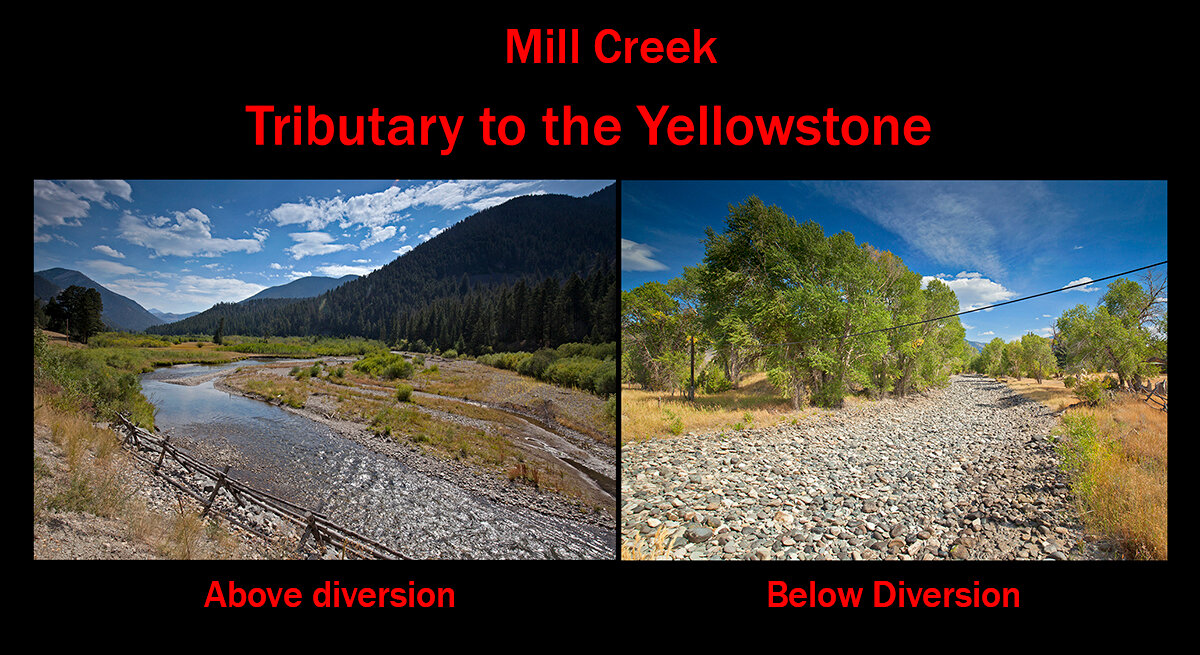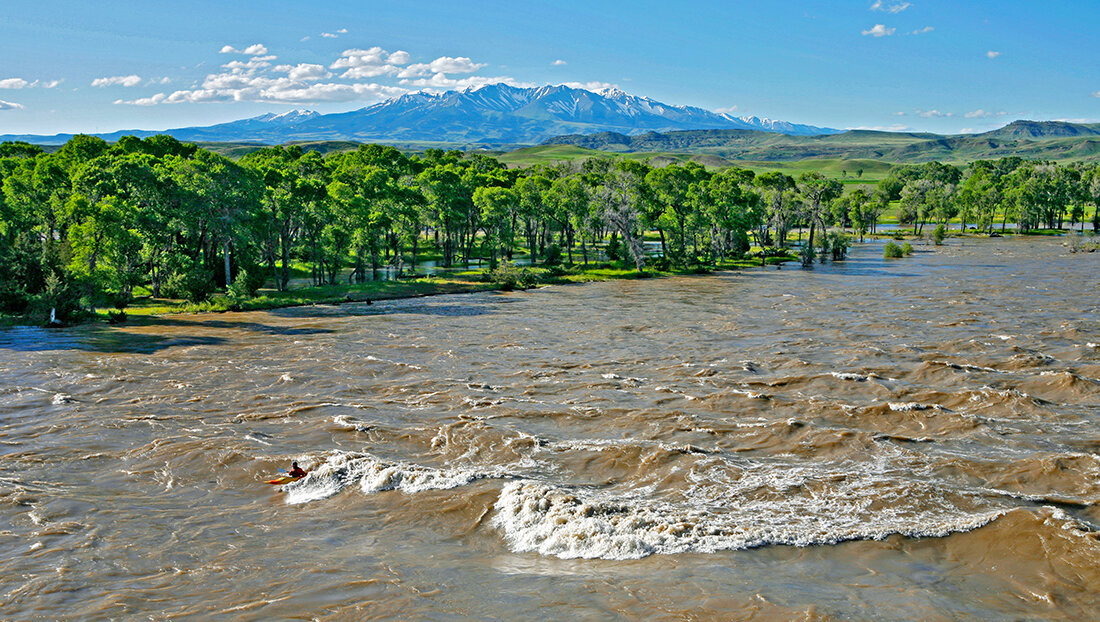The Yellowstone River fish kill, Global Warming, and the path forward.
BY PAT CLAYTON | PUBLISHED APR 29 2017
Ever since dead whitefish began sloshing up on the shores of the mighty Yellowstone River, a lot of ink has been spilled over the status of this most iconic of rivers. To the untrained eye, Paradise Valley and this waterway appear to embody everything that draws people to our rivers. Sprawling views in every direction of a relatively untouched land, clear and cold water teeming with wild trout, and a river corridor supporting all sorts of fauna. When one lifts the rosy glasses a very different picture begins to emerge.
Emigrant Peak, the Audacious and Silly plan to build a mine behind this mountain has raised hackles
Yellowstone River
This brawling river flows natural and protected out of Yellowstone Lake, undammed and wild as it tumbles over one of our most iconic falls then rages through The Grand and The Black Canyons of the Yellowstone. As it exits the Park it runs headlong into humanity. In Gardner, these flows are immediately augmented by an ever increasing amount of treated sewage being directly discharged. Soon after, head gates and canals begin diverting small and large quantities of its precious flow. Cold water tributaries flowing from the Absorakees and Gallatin Range are completely disconnected, being diverted to the farm fields nearby. This critical source of cold water to the heart of the valley is all but lost. What should be a high desert valley turns green for most the summer, golf courses and hay fields suck much of the life force. Water quality quickly begins to diminish as silt, nitrogen, phosphorous, and temperature regimes begin to change. Now, I am not a hydrologist, biologist, or any other sort of ist but I have eyes and see the water turning yellower, warmer, and slower. Governor Bullock said he would follow the science, that science leads to one place, the head gate at every irrigation canal.
Above humanity, the mighty Yellowstone flows clear and cold through the Black Canyon
All this is exacerbated by extensive levying and an ever increasing demand on groundwater. The rip rap that often hides the largest of fish also acts to disconnect the very riparian areas that all flora and fauna rely upon. Back Channels so critical to spawning are left dry in perpetuity, the very hydrology changes as the flow is hemmed in between these rock walls. This acts to wash gravel downstream, where the vast majority of bugs would survive; left in its place is larger substrate not suitable for much other than using as an anchor. Critical spring creeks, Armstrongs and Depuy’s, are actually meant to be side channels and flushed in high water years. Instead they are levied off behind no trespassing signs, privatized for the few and are slowly silted in, which, to a degree, deprives the main stem of this vital cold water infusion. The floods of ’97 actually took this ground back, back hoes quickly repaired the “damage.” Every well and groundwater fed center pivot system is lowering the water table. Along the whole river, springs large and small discharge their cold water into the bottom of the river. This hydrology is being lost with every gallon of water being taken. This water is critical to keep the river cold in summer and where these fish lay to over winter. The AG industry is a resource extraction industry, no different than the oil industry or a mining firm. What they extract is our water, and just like those other industries, they pay little or nothing for it, abuse this public resource for personal gain, and when shit goes bad, the public pays the price and the taxpayer picks up the bill, always.
Headgates dot every main stem and tributary in Montana,
Where are we? According to the best available science, the virus that caused the fish kill has existed in the waterway for years, last summer’s low flows and high temps finally engaged it to fish kill levels. Save the Yellowstone? Much public outcry has been expended on a proposed mine, articles about global warming dot the landscape. While these are huge and important issues there is much more. Marketing campaigns have been launched and donations accepted as people rally against the proposed mine, meanwhile the river dies a death by a thousand cuts. Industrial level commercialization of the resource is furthering the decline as hundreds of guided trips a day pound away at the fish with not so much as a peep about regulating numbers. This is of course exacerbated by the fact global warming and water diversions are hammering other popular rivers. Hoot owl restrictions begin earlier and last longer, the Yellowstone ends up taking the brunt, as people flock to the last open stretch of water.
In the western water wars, above is our share, below is theirs
As Montana’s economy evolves away from resource extraction to tourism, these new industries must unite to protect, improve, and preserve the resources they make money off of. A holistic approach to the greater needs to be implemented. This all starts with minimum in stream flow legislation. Without that everything else is pointless. Single issues like a mine, or small projects like paying hundreds of thousands of dollars to purchase a few CFS from a rancher, are simply not seeing the forest through the trees. Whatever improvements are being made with habitat or flows are nowhere near keeping pace with global warming and increased residential and commercial water use. The pressures on these ecosystems are relentless, occurring every hour of every day, and require valley wide rehabilitation. What is true on the Yellowstone is true on every river.
Yellowstone at full bank, cottonwood bottoms rely on this sort of seasonal flooding, Much of this dies a slow death behind levies.
If this kind of theft occurred at a convenience store, rest assured the perpetrator would not be driving around in a brand new f 350……
This is where I would usually insert a link to relevant groups in regards to minimum stream flow legislation but there seems to be none. Instead we hear platitudes about “resiliency,” neo liberal schemes with fancy names like “mitigation banks,” laughably ineffective voluntary drought irrigation cutbacks, and tears shed over “stakeholders.” These “stakeholders” being the very demographic who deny global warming are in turn blaming it for the lack of water, their rather large straw sucking the precious flow for their own fiscal gain. It may come as breaking news, but we are all stakeholders and this is clearly outlined in our state’s constitution. As the picture of the true costs of global warming on our waterways comes into focus, the reality is, if we are to preserve our cold water fisheries, minimum stream flow legislation is our only course of action. Saying it cant be done is weak tea. So, I give to you one brave man who has stood for what is right for decades, as to why this article is titled the way it is, well you can connect the dots there:
Our past times, many of our professions, and indeed our existance are inherently connected to the environment. Support businesses and manufacturers who hold these values. Patagonia is fearlessly leading the charge, Orvis is quietly a force for good, REI, Black Diamond and many others. Non Profits like the Center for Biological diversity, Earth Justice, the Wild Fish Conservancy, the Upper Missouri waterkeepers, MEIC, and alliance for the Wild Rockies are who to support and more importantly where you want your money to go. Do your research on this, many small advocacy groups do great things well many larger well known organizations sold out decades ago.
There is another way of ranching, good land stewards do this voluntarily, unfortunately they are in the minority. Minimum stream flow legislation is the only way to force their hand on a large scale. It is not an either or scenario:
http://blog.nature.org/science/2017/05/01/recovery-ranching-gone-right/
How Bad can it really be? These three rivers join to form the Jefferson. This was toted as a collaborative success. The lower Jefferson died an ugly death last summer. The fish kill on it was not witnessed because nobody was on it to see. It peaked at over 75 degrees, it looked like a stagnant series of puddles, ranchers were busily digging in the riverbed with their backhoes creating coffer dams to form pools and siphon the last of the water. 20 cfs at the bottom, meanwhile the three rivers that make this river were gushing at nearly 900 cfs. Is 22 cfs a fair allotment?











